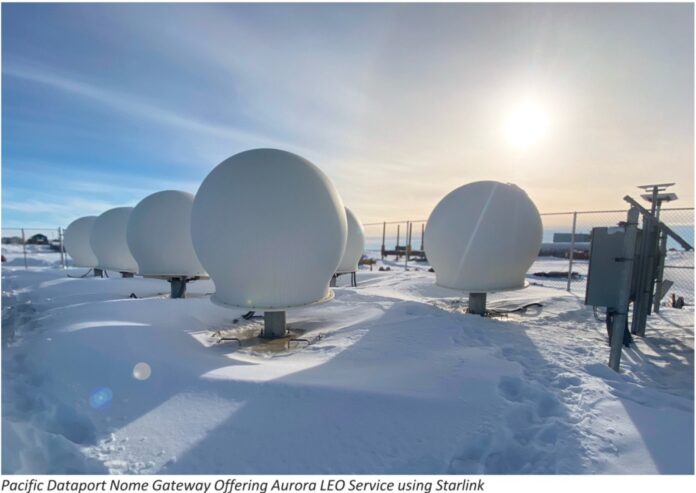Pacific Dataport, Inc., a satellite middle-mile provider based in Anchorage, has officially launched its Nome Gateway, a major step in expanding broadband access to some of the state’s most remote communities.
The new gateway leverages Starlink’s low-earth orbit satellite technology to deliver the company’s Aurora LEO enterprise “backhaul service” to internet service providers serving the North Slope and Northwest regions.
The Nome Gateway is a notable infrastructure achievement for the region, offering more than 10 gigabits per second (a unit of measurement for data transfer rate) of satellite capacity to local ISPs.
It’s the largest commercial satellite capacity ever deployed in a single location globally, the company said. The gateway is designed to meet the growing demands of remote learning, telemedicine, and emergency response in rural Alaska.
By integrating Starlink’s high-speed, low-latency LEO technology into its service platform, Pacific Dataport is providing ISPs with the tools needed to offer reliable broadband to areas where traditional infrastructure is often infeasible due to harsh climate and rugged terrain, the company explained. The gateway also acts as a resilient backup network, helping maintain continuity of service in the event of weather-related or other disruptions.
The collaboration between Pacific Dataport and Starlink combines local expertise with global satellite innovation, creating a scalable and redundant system that can adapt to the evolving needs of Alaska’s underserved regions. The Nome Gateway supports critical connectivity for institutions such as schools, healthcare facilities, tribal organizations, and emergency responders, fundamentally changing how remote Alaskan communities engage with essential services.
This new deployment builds on Pacific Dataport’s broader mission to close the digital divide across the state. In addition to the Nome Gateway, the company continues to develop and operate infrastructure projects like Aurora 4A, a dedicated micro-GEO satellite launched in 2023 with partner Astranis that is designed specifically to serve Alaska’s unique geographic and connectivity needs.
As broadband demands grow, Pacific Dataport plans to replicate the Nome Gateway model in other parts of Alaska, extending service to more rural areas from the Arctic Circle to the Aleutian Islands.

Wow. This reads like a Starlink press release. Why would you go with slower LEO service when you can get 2.5 gig per second with a fiber or microwave connection?
Two reasons there, Rollo:
– The primary use for village internet is network gaming and porn neither of which require anything close to 10gps.
– The cost for StarLink is freakishly low compared to fiber. Like, really low.
Assuming you’re not just trolling note that Alaska is converting to StarLink very rapidly and they’re paying more to do so than they currently pay their legacy ISP. The reason? They’re hoping they never have to deal w/ GCI’s requirement that they call the Philippines the next time GCI’s service poops the bed.
Doubt my statements? Try to get a new StarLink service in ANC or FBX and you’ll be told there’s a waiting list whereas if you want a new GCI service all you need to do is call the Philippines, hold for an interminable period and then listen to a flip chart goofball holler something unintelligible in Tagalog. Then BOOM, the next thing you know the line goes dead and they don’t call back.
The solution for gamer porn freaks is in the sky.
My baby’s up in a rocket machine! (boop boop)
Since she left, she ain’t been seen. (boop boop)
This particular installation can provide well over 10 Gbps. GCI’s first undersea fiber optic system installed in 1999 was only 2.5Gbps for their entire customer base. That undersea system also cost and cost 120 million.
Oh Dear!! They installed them 180 degrees out!! DOH!! Elon, clean up in Nome.
Why do we need PDataport? I get that kind of download speed with Starlink without the middle-man. What is being trumpeted as a miraculous advance in tech is just another rip-off of the Bush, like the Quintillion cable. There is likely a fat grant involved…
No grant involved. PacificDataport is an Alaska based company with boots on the ground. Starlink’s model for Community Gateways is to sell to a local provider who can then utilize the capacity themselves or resell to various others in the community.
Why does Starlink need a middleman? What value do they bring to the customer? Cheers –
Knowledge of the community. It’s a common practice.